|
If a company with current stock price $P had annual earnings per share (EPS)
over the previous twelve months of $E, then the ratio P/E is called the
Price Earnings Ratio.
For "earnings", read: profit,
per share. Earnings for the most recent quarter and for the past twelve months
("trailing earnings")
are reported by Yahoo,
for example.
For example, a stock currently selling for $20.00 had, for the previous twelve months,
a (total) earnings per share of $1.25 so P/E = 20/1.25 = 16.
>Total? What's "total"?
There may be four quarterly earnings each year so we add all four so that ...
>Okay, I got it.
If we bought the stock at $20.00 we might regard the $1.25 earnings as our share of
the company profits. Because we may be more interested in our share in the future -
the next twelve months, not the last - we might calculate the current price
divided by estimated earnings per share over the next twelve months. It's still
Price/Earnings, but now we use estimated future earnings. In any case, both P/E ratios
are used by the investment community. They're called trailing P/E and
leading P/E (or forward) ratios. The most common practice is to quote trailing earnings according
to Generally Accepted Accounting Principles (GAAP) ... since "leading" earnings involve
a guesstimate of the future. (Accountants are reluctant to gaze into a crystal ball, but
financial analysts do it all the time!)
If we put our $20.00 in a bank account and get $1.25 in interest over the next twelve months
we'd say we got
1.25/20 = 0.0625 or 6.25% annual return.
If we put our $20.00 into a stock
and our share of the company earnings over the next twelve months is $1.25 we might want
to equate that to 1.25/20 = 0.0625 or 6.25% "annual return".
Note that 1.25/20 is the reciprocal
of the P/E ratio, namely the E/P ratio.
Note:
P/E may also be described as, "How much do I have to pay to get $1.00 worth of earnings?"
P/E may also be described as, "The number of years over which total earnings would equal the current stock price."
See also PEG Ratio.
E/P may also be described as, "How many pennies of earnings do I get for $1.00 worth of investment?"
>What about stocks with no earnings ... or negative earnings?
You could have infinite P/E ... or negative P/E.
>Perhaps E/P is a better number to consider.
At least it'll never be infinite!
>So, is the market over-priced, today? I mean, if P/E is somehow related to ...
Good question. If we regard E/P, the reciprocal of the P/E ratio, as an indication
of interest rates, then one might expect that when rates go down the P/E Ratio will go up.
>What rates?
Well, how about the 10-year bond rate? If they change, then we'd expect ...
>Why don't you just show me a picture?
Okay. Let's assume that the current P/E Ratio is, say, 25. Suppose, too, that
the P/E Ratio varies inversely as the 10-year bond rate. Then here's a picture of what the
P/E Ratios would/should/could have been over the past thirty years 
Thanks to Don S. for suggesting this notion!
|
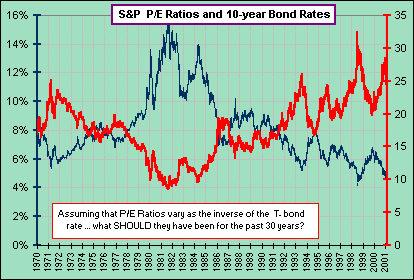
|
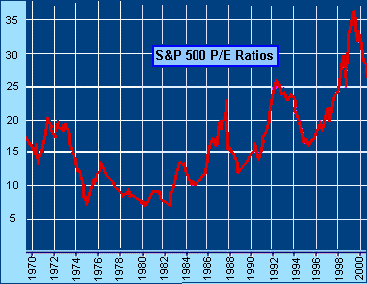
|
>Yeah, but how did the actual market P/E behave?
Here's the S&P 500. It does indeed go up and down, roughly in sync with ...
>But not exactly in sync with the 10-year bond. I mean ...
We don't expect anything to be exact when dealing with the markets, do we?
However, maybe we should work on this relationship. Maybe there's something to be said for ...
>While you're working on it, can we proceed?
More on this stuff, here.
|
|
Because of the possible interpretation as: 1/Price-Earnings-Ratio
as a kind of Rate of Return, we may be leery of buying stock in companies with
high P/E ratios. Of course, if we expect a company to have HUGE earnings in the near future,
we might be happy with buying stock, today, in a high P/E company. Eventually we hope to
see dramatically increased earnings and, as a consequence, increased stock price.
>Does that happen ... often?
Robert Schillerís book Irrational Exuberance has a neat chart showing the annualized return (over various
overlapping ten year periods) vs the P/E ratio (at the start of the ten years). 
One gets the distinct impression that expensive stocks with high P/E have given smaller returns ... in the past.
| 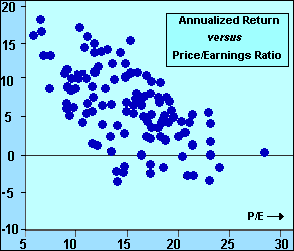
|
>I take it that they're trailing P/Es?
Yes. Unless otherwise specified, P/E means (current price)/(previous annual earnings).
Of course, creative accounting can blur the true earnings of a company. GAAP principles
are loose. Does real estate appreciation count as income?
Do options given to employees count as expenses? Who knows? Not me.
If you count the former and ignore
the latter you get bigger earnings ... and a lower P/E ratio.
That raises the question:
|
"How quickly must earnings grow in order to justify a current P/E ratio?"
|
This suggests that we consider the ratio of P/E to Earnings Growth Rate:
the PEG ratio. Some investors say that a PEG less than "1" means the stock is cheeep.
>What's the Earnings Growth Rate?
Is that a percentage or an estimate ... and why less than "1" ... and
It may be the estimated growth rate, for earnings, or it may be historical. For example, we
consider two companies: A has a P/E ratio of 30 and B a P/E ratio of 20. One might
consider the latter to be the better investment - or, at least, the "cheeeper" stock -
but if their Earnings Growth rates were 40%
for A and 15% for B, their PEGs would be 30/40=0.75 and 20/15=1.3 so the former
looks better ... PEG-wise. In fact, one might consider A to be selling for just 75% of
its "Fair Value" while B is overpriced at 130% of its ...
>Fair Value? What the heck is ...?
The PEG Ratio is a notion first called the
Fool Ratio and can be used like so:
Suppose one assumes an earnings growth rate of, say, 25% and a current P/E
Ratio, say P/E = 30, then the PEG ratio would be 30/25 = 1.2, but if the price were
suddenly reduced by a factor of 1.2 then the PEG Ratio would be "1" which separates
cheep stocks from expensive stocks ...
>You're kidding, right?
Pay attention.
If the stock is currently selling at $30, then $30/1.2 = $25 and that is
sometimes called the stock's Fair Value, but some analysts use a PEG ratio of 1.5 or 2.0
in order to calculate a Fair Value and others use a completely different definition of
Fair Value.
Here's a calculator for the Fool's "Fair Value" (using PEG=1):
>So if there actually is a dramatic growth in earnings, then
buying a high P/E stock may be okay ... okay?
Suppose we consider a startup company with microscopic earnings.
Its P/E will be high, but perhaps its earnings growth rate will also be high. Eventually
we suspect that (if it survives) the company will have a more normal P/E ... like other
companies in its peer group.
If we
- Assume some constant annual earnings growth rate (over the next ten years), like 20% per year.
- Assume that the P/E ratio will decrease in some sensible manner to a more
normal value (over ten years).
- Then we can determine the price (over the ten years) as
Price = (P/E)x(Earnings).
>A picture is worth a thousand ...
Okay, here's a picture which assumes some reduction in P/E ratio to 20% of its current value (after
ten years) and also assumes constant earnings growth rates (from 10% to 25% per year).
The growth (or decay!) in stock price can then be determined ... and is also shown:
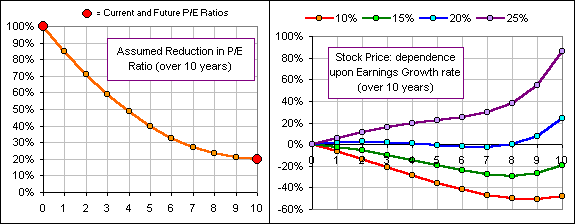
Fig. 1a and 1b
>The graph of P/E ... I don't understand where you got it.
I invented it. It's actually a parabola with its minimum after 10 years ... since I expect
that the P/E ratio would decrease more rapidly at first, then more slowly.
>And the right chart, Fig. 1b? It says we're likely to lose money
on this stock unless there's a big earnings growth. It also suggests that if we wait
long enough, say for twenty years, our stock gain will eventually be positive. Am I right?
Yes, but remember it's based upon our assumptions - which may or may not be valid.
>But some companies have HUGE P/E ratios and HUGE earnings growth and ...
Okay, here's another chart where the P/E ratio is reduced to just 2% of its current value and
the earnings growth rates are maintained (over ten years!) at 25% to 40%:
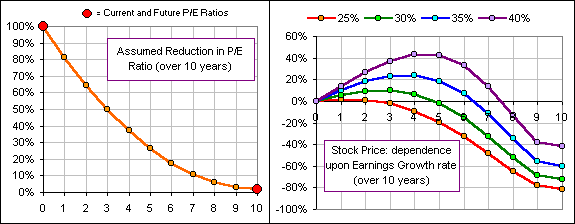
Fig. 1c and 1d
>I'd sell after five years!
Me too.
Here's another thing to consider.
Suppose:
- The P/E Ratio stays fixed over N years
- Annual Earnings Growth is R (12.3% annual growth means R = 0.123)
- Then the stock price, P, will grow at the same rate as the Earnings, namely R.
On the other hand, suppose:
- The Price/Earnings Ratio changes from P(0)/E(0) = A to P(N)/E(N) = B over N years
- Earnings grow from E(0) to E(N) = E(0)(1+R)N over N years
(at the annualized Rate of R)
- Then the Stock Price goes from P(0) = A E(0) to P(N) = B E(N)
- Hence the N-year gain factor in stock price is P(N)/P(0) = (B/A) E(N)/E(0) = (B/A) (1+R)N
- Hence the annual gain factor for the stock price is (B/A)1/N (1+R)
For example:
If the P/E goes from 25 to 30 over 10 years, the stock Price will have
an annualized growth factor
which is (30/25)1/10 = 1.0184 times the
Earnings growth factor.
If Earnings grow at 15% (annualized), the growth factor is 1 + R = 1.15 so the
Price
growth factor
would be (1.0184)(1.15) = 1.171 so the annualized gain in stock price is 17.1%.
>So, is P/E ratio the most important thing to consider when buying a stock?
Not at all. There's a jillion financial numbers which are used to gauge a company's worth,
including, for Dot Coms, comparing the stock price to the number of unique site visitors
... called the Price-to-Eyeballs or  ratio. ratio. 
|
Market Indexes and P/E Ratio for an Index (or Portfolio or Mutual Fund)
|
Because a P/E ratio may be infinite, any weighted average*
of P/E ratios will be infinite if
even a single component has zero earnings. For this reason, it's not reasonable to consider
a straight (weighted) average of P/E ratios ... as is suggested in some places. (Gimme a
minute or three and I'll find a reference!)
To avoid the problem of calculating a P/E ratio
when one or more components (of an Index or Mutual Fund) has a P/E of infinity, some
just ignore these components - replacing their P/E by ZERO.
(Apparently, Morningstar did this until recently.
See the Street article.)
* If W1, W1, ... WN
are positive numbers, then
{
W1X1+W2X2+ ...+WNXN
} /
{
W1+W2+ ...+WN
} =
ΣWX / ΣW
is a weighted average of the Xs ... and the Ws are called the weights.
For a weighted average of P/E ratios, X = P/E.
Barra, for example,
calculates the P/E ratios for their Indexes according to:
"The inverse of the capitalization-weighted average of the individual constituent Earnings/Price ratios"
If E = Earnings per share,
P = stock Price,
n = number of outstanding shares and
M = Market capitalization = nP,
that means that their P/E ratio is the inverse of:
Σ[M*E / P] / Σ[M]
that's the "capitalization-weighted average" of E / P
= Σ[nP*E / P] / Σ[M]
Σ means add 'em all up
= Σ[nE] / Σ[M]
= (Total Earnings of all companies in the Index) / (Total Market cap).
That means:
|
P/E = Σ[nP] / Σ[nE] = {TotalMktCap} / {TotalEarnings}
|
... at least for the Barra Indices.
>It's like buying all the companies that make up the Index - that'd
cost "TotalMktCap" - and collecting all the Earnings - namely "TotalEarnings" -
and calculating your {Total Price Paid}/{Total Earnings Recieved}, right?
Very good ... but it's spelled received.
>And companies with negative earnings? What about ...?
You could include negative earnings (decreasing TotalEarnings, thereby
increasing the calculated P/E ... like making the earnings from the Good Companies cover the
losses from the Bad Companies) or you could replace negative earnings by zero earnings. Barra
does both. For the Nasdaq 100, the difference can be ... uh ... dramatic: see
Nasdaq 100 P?E.
>And for Indexes (or is it Indices?) that are NOT Market Cap Weighted?
I may be wrong, but I thought that some Indices were calculated like so:
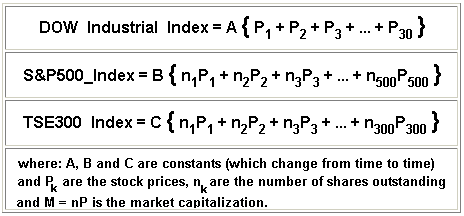 Yes, the S&P 500 is just (1/divisor)ΣnP, the sum of the
market capitalizations of the components, with the constant
Yes, the S&P 500 is just (1/divisor)ΣnP, the sum of the
market capitalizations of the components, with the constant
B equal to the reciprocal of something called the divisor; it changes from time
to time (such as when a stock is added to or deleted from the index). The DOW, on the other
hand, is a straight, garden variety average of thirty stock prices (with a fix-up factor, A,
out front. See a note on Indexes).
>But that makes the S&P formula the same as for the TSE 300.
Yes. Standard and Poor's actually computes the TSE 300 index.
>So both are Market Cap Weighted, eh?
Market Cap Weighted what? Actually, I'd prefer to call then Float Weighted
Stock Prices (but that's my own description ... others call it Mkt Cap weighted).
The DOW, by the way, is sometimes called a Price Weighted Index.
>Mamma mia! It seems that if you add up all the Whatzits to get an Index,
then it's called a Whatzit-weighted Index, eh?
Wierd, eh?
>Yeah ... and it's spelled weird.
Okay. We start with a bunch of money, namely $A, and consider an N-stock Index.
To increase our understanding (hopefully!) we'll consider the following three scenarios:
- We divide our money into N equal piles and buy equal dollar amounts
of each stock in the Index. Now A/N dollars divided by the stock
price, Pk, gives (for the kth stock purchase)
(1) ....
Sk = A/(NPk) EQUAL weighted
shares of each stock in the Index (where the Price,
Pk, varies from stock to stock, of course, so we buy a variable number of shares). We now have
equal dollars invested in each stock.
- A different tack is to buy, with our $A, an equal share amount of
each stock. We now have more money invested in stocks with higher prices.
In any case, if we buy S shares of the kth stock, the total cost is
S P1+S P2+ ... +S PN=$A
so the number of shares of each is
(2) .....
Sk
= A/ΣPi PRICE weighted, like the DOW
... and this is the same for every stock (meaning every "k").
- Finally, we can buy a number of shares which is proportional to the total number of outstanding
shares of each stock in the Index. That is, if stock #1 has n1 outstanding
shares and stock #2 has n2 outstanding shares etc. then we buy
C n1 shares of stock #1 and C n2 shares of stock #2 etc.
where "C" is a constant (which we'll determine momentarily).
Our total cost is then
C n1P1+C n2P2+...+C nNPN = $A
so the constant can be determined as:
C
= A/ΣniPi
and the number of shares of each stock is:
(3) .....
Sk
= Ank/ΣniPi MARKET CAP weighted, like the TSE
where the number of shares, nk, varies from stock to stock, of course, so we buy a variable
number of shares.
Okay. We purchase a number of shares of each of the N stocks, depending upon the scheme we
follow: (1), (2) or (3). Then we see what happens to our initial $A as time progresses and
the N stocks do their thing ... like random price fluctuations.
|
To see what a difference the weighting makes, we'll consider five of the largest cap stocks
on the DOW, starting with their outstanding shares and prices as of Feb 19, 2001 and
letting each vary over the following twelve months in some random fashion, as indicated
in Fig. 2.
Here, the pertinent numbers are:
| Stock | Shares | Price |
| GE | 9.91 | $47 |
| Merck | 2.31 | $77 |
| Walmart | 4.47 | $52 |
| Exxon | 3.48 | $84 |
| Microsoft | 5.34 | $57 |
Table 1
where the number of (outstanding) shares is in Billions.
|
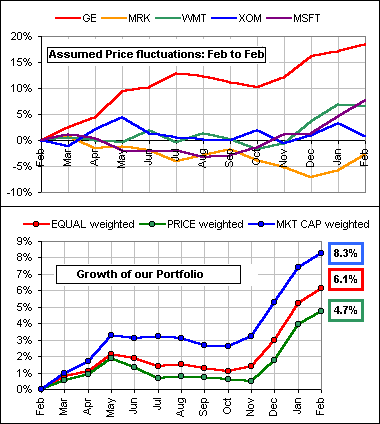
Fig. 2
|
If we invest A=$10,000, subdividing this among the five stocks according to schemes
(1), (2) or (3) we get:
| Number of Shares |
| STOCK | EQUAL | PRICE | MKT CAP |
| GE | 42.55 | 31.55 | 67.29 |
| Merck | 25.97 | 31.55 | 15.68 |
| Walmart | 38.46 | 31.55 | 30.35 |
| Exxon | 23.81 | 31.55 | 23.63 |
| Microsoft | 35.09 | 31.55 | 36.26 |
Table 2
|
| Dollars Invested |
| STOCK | EQUAL | PRICE | MKT CAP |
| GE | $2000 | $1483 | $3163 |
| Merck | $2000 | $2429 | $1208 |
| Walmart | $2000 | $1640 | $1578 |
| Exxon | $2000 | $2650 | $1985 |
| Microsoft | $2000 | $1798 | $2067 |
Table 3
|
>Wait! How do you get those numbers. I understand the $10K divided
into five EQUAL $2K in Table 3, but ...
Okay, let's calculate the number of shares of each stock, according to the schemes outlines above,
namely formulas (1), (2) and (3).
- For EQUAL weights, we invest equal dollar amounts, namely $2000,
in each stock. Since GE costs $47, we buy 2000/47 = 42.55 shares,
as in Table 2 (and similar calculations for the other four stocks).
- On the other hand, for PRICE
weighted, we buy the same number of shares, given by formula (3).
We buy S = A/ΣPi
= 10000/(47+77+52+84+57) = 31.55 shares of every stock. (2nd column of Table 2)
- On the other hand, for MKT CAP weights, we use formula (3):
Sk
= Ank/ΣniPi
so, for the third stock (k = 3), namely Walmart, we buy
S3
= 10000(4.47)/(9.91*47+2.31*77+4.47*52+3.48*84+5.34*57) = 44700/1473 =
30.35 shares (and similar calculations for the other four,
where we used the numbers in Table 1).
>But the number of shares is in the billions!
That's okay. The number of shares occurs in both numerator and denominator, in formula (3), so
we can ignore all those extra zeros.
>According to Fig. 2, Market Cap weighted is the best, eh?
Not necessarily ... just for this example. But let's analyze:
>I thought we were talking about P/E ratios!
Patience.
Let's look carefully at the three schemes.
In each case we start with a fixed number of shares, different for each stock - except for
case (2): PRICE weighted, like the DOW, where we buy an equal number of shares of each.
- We'll call these number of shares of each stock:
S1, S2, ... SN.
- We'll call the stock prices:
P1, P2, ... PN.
- Then our portfolio is worth:
A = S1P1+S2P2+...+SNPN.
- Suppose stock #1 increases by a gain factor g.
(g = 1+r = 1.23
means the stock increased by r = 0.23 or 23%.)
Then our portfolio is worth:
gS1P1+S2P2+...+SNPN.
- The increase in our portfolio is
ΔA = gS1P1 - S1P1 = rS1P1.
- The gain for our portolio is then ΔA / A.
(If this is 0.12 it means our portfolio increased by 12%)
- Hence, if stock #1 has a gain of r, our portfolio will have a gain of
r S1P1 /
ΣSkPk and since
S1P1 /
ΣSkPk is just the fraction
of our portfolio devoted to stock #1, we conclude that:
|
If a stock increases by R%, and the stock is B% of our portfolio,
then our portolio will increase by RB%.
|
>Isn't that obvious?
Yeah, maybe. It means that our portfolio will go UP (or DOWN) most rapidly if it
devotes MOST dollar resources to the stock that goes UP (or DOWN) most rapidly.
Look again at Fig. 2 where (in our random selection of future stock prices) GE increased
most rapidly. The Mkt Cap weighting gave GE the biggest fraction of our portolio (because it
had the biggest capitalization: see Table 1) - so Mkt Cap weighting won the day.
On the other hand, Merck and Exxon had the largest stock prices (see
Table 1, again!), so they had the largest weight in Price weighting,
and (alas) they were the stocks that had the poorest performance (Fig. 2).
So Price weighting gave us a lousy result.
>And EQUAL weighting? Who uses that?
I have no idea, but you might want to take a peek at this.
>Can we talk about P/E ratios?
Sure. We now have several prescriptions for determining a P/E ratio for a basket of stocks.
We've got the simple-minded garden-variety average:
{
W1(P/E)1+W2(P/E)2+ ...+WN(P/E)N
} /
{
W1+W2+ ...+WN
} =
ΣWk(P/E)k /
ΣWk
where we can choose any weights, Wk, we please.
On the other hand we can choose
schemes (1), (2) or (3) and, for each choice, we have a number of shares of each stock in the
Index, and each stock has an associated Price and Earnings so we can calculate
the total Earnings (for all of our shares) and the total Price paid for those
shares and compute the Ratio: {Total Price} / {Total Earnings}
... or (to avoid
infinite P/E ratios) we can do as Barra does and calculate the reciprocal of
E/P = {Total Earnings} / {Total Price}
If P = stock price, S = number of shares we hold (according to
schemes (1), (2) or (3)),
E = (leading or trailing) earnings, the prescription would be:
>But the number of shares depends upon $A ... the amount I invest.
What do I use ...?
Choose A = $1.00 because it matters not a whit. The value of A is a factor of all the
Sk in both numerator and denominator ... so it cancels out.
>Don't you have any pictures? A picture is worth a thousand ...
On the other hand, one can simply calculate the P/E for an Index as
{Index Value}/{Total Earnings}. For example, if the S&P 500 Index were 1200 and the cumulated
earnings (per share) of all 500 companies were $40, we could give the P/E
as 1200/40 = 30.
This prescription would give:


|








 ratio.
ratio. 

